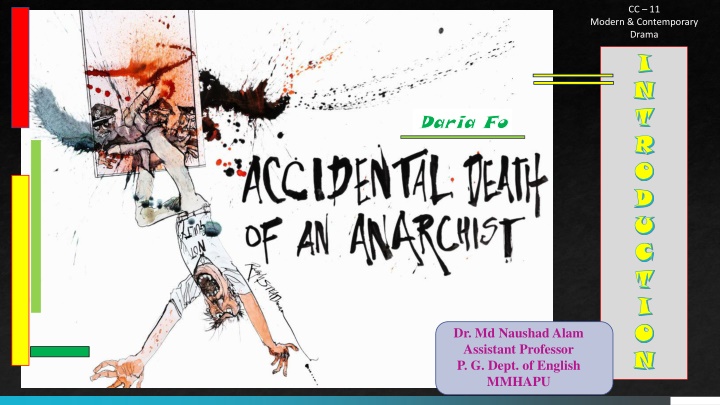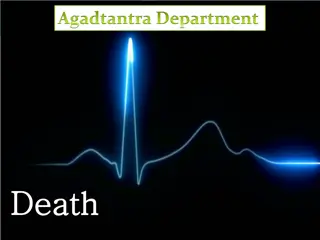Analysis of Dario Fo's "Accidental Death of an Anarchist
Dario Fo's play "Accidental Death of an Anarchist" explores themes of police corruption, government collusion, and the suspicious death of an anarchist in police custody. The play delves into issues of impersonation, infiltration, and double-talk, shedding light on societal corruption and manipulation. Through its satirical portrayal of characters like the Maniac, Bertozzo, and the constables, the play critiques the flawed police system and societal hierarchies. Fo's work has gained international acclaim for its sharp commentary on political corruption and has been widely staged worldwide.
Download Presentation

Please find below an Image/Link to download the presentation.
The content on the website is provided AS IS for your information and personal use only. It may not be sold, licensed, or shared on other websites without obtaining consent from the author.If you encounter any issues during the download, it is possible that the publisher has removed the file from their server.
You are allowed to download the files provided on this website for personal or commercial use, subject to the condition that they are used lawfully. All files are the property of their respective owners.
The content on the website is provided AS IS for your information and personal use only. It may not be sold, licensed, or shared on other websites without obtaining consent from the author.
E N D
Presentation Transcript
CC 11 Modern & Contemporary Drama I I N N T T R R O O D D U U C C T T I I O O N N Daria Fo Dr. Md Naushad Alam Assistant Professor P. G. Dept. of English MMHAPU
Accidental Death of An Anarchist: Introduction Dario Fo s Accidental Death of an Anarchist (1970) responds to events unfolding in Italy in the late 1960s and early 1970s. Generally, it looks at police corruption and suspicions regarding the government's collusion in this corruption. More specifically, it addresses the actual death of an anarchist who was being held in police custody following the bombing of a Milan bank that killed sixteen people and wounded about ninety. The police asserted that the anarchist's death was a suicide, that the man threw himself from a fourth-floor window in despair at being found out for his crime. At the subsequent inquest, the presiding judge declared the death not a suicide but an accident. Most Italians believed that the death was the result of overly harsh interrogation techniques, if not a case of outright murder on the part of the interrogators. Accidental Death of an Anarchist is mainly about police corruption, underscored by the play's focus on impersonation, infiltration, and double-talk. A fast-talking major character, the Maniac, infiltrates a police headquarters. PAGE 2
Posing as an investigating judge, he tricks the policemen into contradicting themselves and admitting that they are part of a cover-up involving the death of an anarchist. In infiltrating police headquarters by misrepresenting himself (impersonation), the Maniac reminds audiences of how most political groups in Italy, particularly left-wing groups, were infiltrated by police agents who acted as informers. The Maniac's flip-flop of point of view and statement achieves much the same effect as his impersonations do. His confusing speechifying leads to the police contradicting themselves, so that the Maniac, in all of his deceptions and distortions, is a precise reflection of what the play is designed to expose. Accidental Death of an Anarchist is one of Fo's most popular plays both within and outside Italy. It has played around the world over the years to millions of people, a popular choice of directors who want to point to corruption in their midst. Pluto Press (London) put out the first English version, translated by Gavin Richards. In 1992, Methuen published a fine set of volumes of Fo's plays, which included Accidental Death of an Anarchist. PAGE 3
Accidental Death of An Anarchist: Characters Bertozzo Bertozzo is the amalgam of several real-life police officers. In Italy, jokes about the carabinieri, one of the three police forces, are common; Bertozzo fits the stereotype that is typically the target of these jokes. Throughout the play, Bertozzo is the butt of jokes and recipient of mocking laughter and physical abuse. This contributes to the play's slapstick humor, while reminding the audience of the abuse the anarchist likely endured during his interrogation. The Maniac The Maniac is the pivotal character in the play. While he has no counterpart in real life, he speaks the majority of the lines and was played by Fo himself in the original staging. It is through the Maniac that Fo satirizes the police, reveals the inconsistencies in their stories, demonstrates the questionable nature of their interrogation techniques, and presents counter-information to what was being presented about the case in the press. Constables The constables are foolish bystanders, reminiscent of the bumbling, incompetent policemen of detective stories. They follow orders immediately and agree with whatever anyone says. By depicting the constables as such simple- and single-minded people, Fo pokes fun at the hierarchy of the police bureaucracy.Though there were four constables in the office at the time of Pinelli's death, there is no direct link to any of the real-life constables to the characters in the play. PAGE 4 PAGE 4 PAGE 4
Inspector The Inspector is based closely on commissario Luigi Calabresi, who was commonly believed by leftist organizations to have been directly involved with the death of the anarchist Pino Pinelli. n the play, the Inspector believes that the Maniac is a judge who has come to reopen the inquiry into the death of the anarchist. He tries to prove his innocence, but ends up incriminating himself through the Maniac's clever questioning. Superintendent The Superintendent is based on Marcello Guida, the head of police in Milan. While he was not present at Pinelli's death, he took part in the cover-up, denying at first any records of the interrogation and later changing his story. He was also involved in the framing of Pietro Valpreda, another anarchist who was wrongly accused of planting bombs and imprisoned for three years. Like the Inspector, the Superintendent believes that the Maniac is a judge investigating what happened the night of the anarchist's death. He reacts defensively when he thinks the Maniac is against him, but is happy to go along with whatever the Maniac says if it will get him out of trouble. Journalist The Journalist was inspired by Camilla Cederna, a real-life journalist who investigated the case of Pino Pinelli's death. She uncovered police corruption and assisted Fo in his research for the play. Unlike the other comedic characters, the Journalist is a straight role. She is an accurate portrayal of an experienced journalist on a quest to reveal the truth. PAGE 5 PAGE 5
Critical Analysis Internationally popular, Accidental Death of an Anarchist is based on a 1969 incident in which an anarchist railway worker, arrested in connection with a terrorist bombing in Milan, fell to his death from a fourth-story window at police headquarters during the course of an interrogation. His death was officially declared a suicide. The police report held blatant contradictions. Subsequent investigation revealed the probable innocence of the worker. Fo set out to demolish the official story through the play s production at his collective, La Commune. Fo created one of his most successful roles for this play, that of a maniac who infiltrates the Milan police headquarters and carries out a number of impersonations in order to force the police to admit the illogic of the worker s alleged leap from a window and to confess their culpability. The Maniac resembles the Zanni figure of the commedia dell arte. Called a grotesque farce by its author, the play s dramatic action takes the form of a mock investigation carried out by a make-believe judicial examiner. A madman impostor (the Maniac), summoned to police headquarters to answer to charges of false identity, luckily happens to steal the file on the anarchist s death. He then changes his identity, posing as an investigating judge, purportedly to ascertain that the police have constructed a solid case which can be upheld by the magistrates. PAGE 6 PAGE 6 PAGE 6
In the course of the interrogation of the officers, the Maniac is forced to assume numerous disguises. He exposes the blatant contradictions and lies of the police, who admit their guilt, whereupon the Maniac invents for them another outrageous story about the anarchist s fall. The arrival of a journalist and police who recognize him forces the Maniac s disclosure and his threat that he has taped their confession and plans to blow them all up to destroy the capitalist police state. One confused policeman handcuffs his superiors to the wall. In a Brechtian-like conclusion, the Maniac confronts the journalist and the audience with a choice of alternate endings: to free the police, which will result in the impostor s death and perpetuate police duplicity, to allow the Maniac to escape with evidence of police duplicity, or to allow the Maniac to escape with evidence of police guilt. Fo s purpose throughout is to arouse the audience s indignation at police authoritarianism. The play s farcical action and zaniness counterpoint the serious indictment being made. Moreover, the play s use of a historical event demonstrates the directness of Fo s left-wing politics. The play has been performed in more than forty countries, including the United Kingdom and the United States. ..the End. PAGE 7 PAGE 7 PAGE 7























